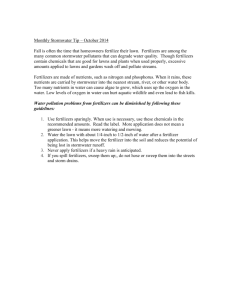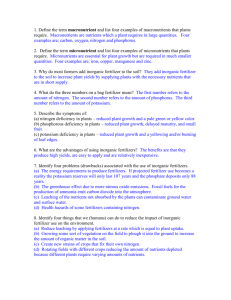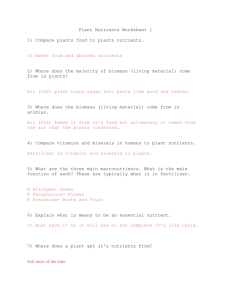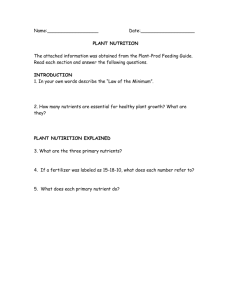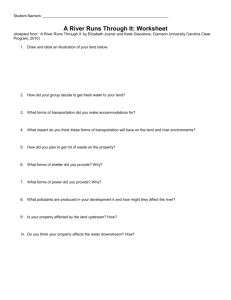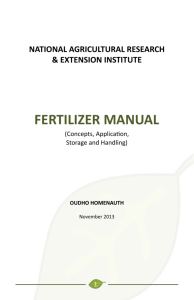The Basics of Fertilizing
advertisement
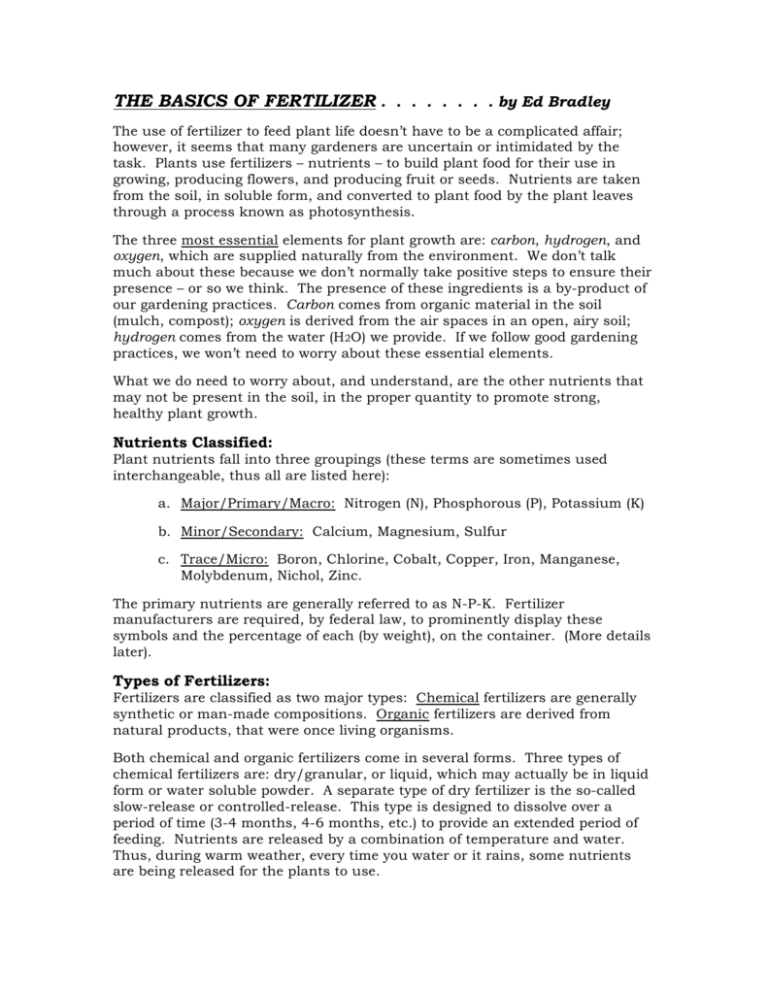
THE BASICS OF FERTILIZER . . . . . . . . by Ed Bradley The use of fertilizer to feed plant life doesn’t have to be a complicated affair; however, it seems that many gardeners are uncertain or intimidated by the task. Plants use fertilizers – nutrients – to build plant food for their use in growing, producing flowers, and producing fruit or seeds. Nutrients are taken from the soil, in soluble form, and converted to plant food by the plant leaves through a process known as photosynthesis. The three most essential elements for plant growth are: carbon, hydrogen, and oxygen, which are supplied naturally from the environment. We don’t talk much about these because we don’t normally take positive steps to ensure their presence – or so we think. The presence of these ingredients is a by-product of our gardening practices. Carbon comes from organic material in the soil (mulch, compost); oxygen is derived from the air spaces in an open, airy soil; hydrogen comes from the water (H2O) we provide. If we follow good gardening practices, we won’t need to worry about these essential elements. What we do need to worry about, and understand, are the other nutrients that may not be present in the soil, in the proper quantity to promote strong, healthy plant growth. Nutrients Classified: Plant nutrients fall into three groupings (these terms are sometimes used interchangeable, thus all are listed here): a. Major/Primary/Macro: Nitrogen (N), Phosphorous (P), Potassium (K) b. Minor/Secondary: Calcium, Magnesium, Sulfur c. Trace/Micro: Boron, Chlorine, Cobalt, Copper, Iron, Manganese, Molybdenum, Nichol, Zinc. The primary nutrients are generally referred to as N-P-K. Fertilizer manufacturers are required, by federal law, to prominently display these symbols and the percentage of each (by weight), on the container. (More details later). Types of Fertilizers: Fertilizers are classified as two major types: Chemical fertilizers are generally synthetic or man-made compositions. Organic fertilizers are derived from natural products, that were once living organisms. Both chemical and organic fertilizers come in several forms. Three types of chemical fertilizers are: dry/granular, or liquid, which may actually be in liquid form or water soluble powder. A separate type of dry fertilizer is the so-called slow-release or controlled-release. This type is designed to dissolve over a period of time (3-4 months, 4-6 months, etc.) to provide an extended period of feeding. Nutrients are released by a combination of temperature and water. Thus, during warm weather, every time you water or it rains, some nutrients are being released for the plants to use. Organic fertilizers (other than natural manures) may also come in two types: • Dry meals (fish meal, alfalfa meal, bone meal, blood meal, cottonseed meal, etc.); • Liquids (fish emulsion, seaweed/kelp, molasses, compost tea, etc.). Function of Nutrients: Each of the 15 nutrients provides a specific benefit to plant life. The classification of fertilizers (Major, Minor, Trace) gives you a clue as to the quantity needed between the different groups. a. The element we consider the most critical is Nitrogen (symbol N). Nitrogen is the primary element that affects productivity of the plant. It is directly responsible for vegetative plant growth. Without sufficient nitrogen, the leaves will lack their lush green color and growth will be stunted – the leaves cannot perform the photosynthesis process to produce plant food. b. Phosphorous (symbol P) promotes strong root systems, large flowers and fruits. It also develops disease resistance in plants. A small amount of phosphorous goes a long way, as they say. Many soils have an excessive amount of phosphorous that has accumulated from excessive use of fertilizers with high phosphorous content. We all tend to want the biggest flower, strongest stem, biggest fruit, etc. So, we use a “super-bloom” product like 10-50-5 – which is 50% phosphorous!! Phosphorous is used slowly; it rarely moves in the soil, and is generally not leached through the soil. Thus, an excess is easily created. An excess of phosphorous will “lock up” essential secondary and micro elements, thereby making them unavailable to the plant. Don’t over-use phosphorous. c. The third element for healthy soil is Potassium (symbol K), which promotes vigor and color. It makes flowers “pretty”. Potassium is needed for the plant to create sugars (plant food). It is also essential to the plant’s capacity to resist disease, survive cold temperatures, and provide drought protection. The minor and trace elements are essential for vigorous and healthy plant growth; however, we generally don’t need to worry about them for two principal reasons: a. They are required in very small quantities, and unless you are working with an extremely poor soil, your soil will normally contain an adequate amount of these ingredients. b. All fertilizer manufacturers recognize the need for these minor and trace elements, and therefore, most balanced fertilizers contain an adequate amount. For example, a typical lawn fertilizer (19-5-9) will contain, in addition to N-P-K, sulfur, iron, copper, manganese, molybdenum, and zinc. c. There is, however, one trace element that we need to be concerned about, and that is iron. With the alkaline soils and water we have, “iron chlorosis” is a fairly common symptom in this area, which is manifested as light green or yellowish leaves. Soils in the alkaline range cannot release naturally available iron. What To Feed: There is a plethora of excellent chemical and organic fertilizers on the market, with a good balance of N-P-K and minor and trace elements. Best results are normally obtained by using a combination of available fertilizers – dry, granular, liquid, synthetic and organic. Read the manufacturers labeling to know the amount of N-P-K you are getting, plus what minor and trace elements are included. In the set of three numbers, the first number is Nitrogen (N), the second number is Phosphorous (P), and the third number is Potassium (K). In a formula of 19-5-9, with a 50 pound bag, you are getting: Element Nitrogen Phosphorous Potassium Total Percent 19% X 50 5% X 50 9% X 50 33% X 50 = = = = Weight 9.5 pounds 2.5 pounds 4.5 pounds 16.5 pounds The remainder is filler or inert material. Different elements (N-P-K) are usually different colored granules. Organic fertilizers are generally slow-acting because they have to decompose to become plant nutrients; however, this also means their benefits are longerlasting. Liquid fertilizers last about 2 weeks. Granular fertilizers last about 4 – 6 weeks. Slow-release will last from 3 – 4 months up to 7 – 8 months depending on the formula used. A simple feeding program would consist of: a. Liquid feeding every 2 weeks during peak blooming seasons – spring and fall. b. Use one application of a granular fertilizer for May – June. c. Slow-release (3 – 4 month formula) for summer months (June – September). d. Resume liquid feeding, or one application of granular fertilizer, in early September for fall bloom cycle. e. Don’t feed later than October 15th.
